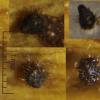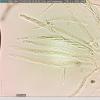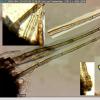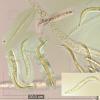
20-12-2025 23:08
Patrice TANCHAUDBonsoir, récolte sur sol sablonneux dans l'arri�

20-12-2025 15:47
Mirek GrycHi.These grew on pine wood that was heavily covere

18-12-2025 21:17
Pol DebaenstThe identification took me to Byssonectria deformi

15-12-2025 07:09
 Danny Newman
Danny Newman
indet. Rutstroemiaceae sp. on unk. fallen leavesMc

19-12-2025 10:10
Patrice TANCHAUDBonjour, récolte réalisée en milieu dunaire, a

18-12-2025 17:23
 Bruno Coué
Bruno Coué
Bonjour,je serais heureux d'avoir votre avis sur c

18-12-2025 18:07
Margot en Geert VullingsThese plumes were found on rotten wood.They strong

17-12-2025 18:35
 Michel Hairaud
Michel Hairaud
Bonjour à tous/Hi to everyone I am passing along
This asco has grown in moist chamber on debris from perennials, collected 29.05.2015 in Stange, Norway.
Perithecia about 420 x 300 µm,
Spores 42 x 3 µm, strait when young. I could not see any septation, but I think they are not fully grown?
Asci 125x 9 µm,
Hairs up to 261 x 7.7 µm, hair wall up to 2.4 µm thick.
I think it is a Lasiosphaeria or Hilberina. After studying the information I found available on the web the closest I can find is L. breviseta, but the substrate does not fit?
Thank you for any help
Regards Per Vetlesen

the ascospores are likely those of H. breviseta and as you say, the septation is often delayed. The growth in moist chamber may have affected some other morphological traits like the length of the setae. This is a fairly rare species, at least in my region.
Jacques
Did you note the recent paper by Andrew Miller cs that he has made available on this forum: http://www.ascofrance.fr/search_forum/29631 ? It includes a key to all Lasiosphaeria s.l. and L. breviseta is now included in the (newly created) genus Hilberina. Reference is also made to another species which is similar and may be conspecific: Hilberina rhynchospora.
I have found Hilberina breviseta in the Netherlands too. I will add some more details later because this does seem to be a rare or at least unknown species.
The spore form is quite striking!
Eduard
Thanks for the quick reply:-)
L. breviseta is a rare species and that is why I doubted it could be right.
No, I have not seen the paper by Andrew Miller cs, but after reading it I still think it must be L. breviseta despite it is growing on a different substrate. Andrew Miller did not observe any septation on the spores.
The material consist of just a few fruit bodies, some are still in the moist chamber in hope of mature spores. In about a week I will have a new look at in the moist chamber in hope of mature spores.
Per





